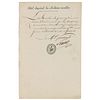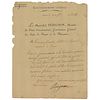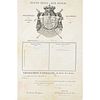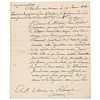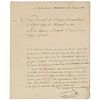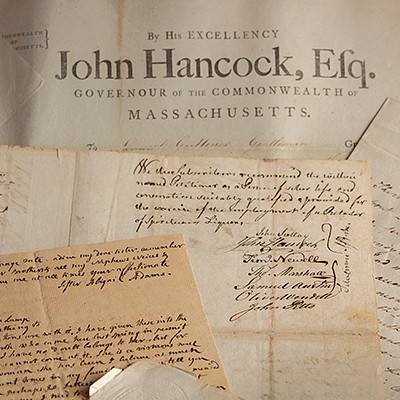Napoleonic Marshals Collection of (25+) Autographs
Two ways to bid:
- Leave a max absentee bid and the platform will bid on your behalf up to your maximum bid during the live auction.
- Bid live during the auction and your bids will be submitted real-time to the auctioneer.
Bid Increments
| Price | Bid Increment |
|---|---|
| $0 | $5 |
| $50 | $10 |
| $200 | $25 |
| $500 | $50 |
About Auction
Jul 12, 2023
RR Auction support@rrauction.com
- Lot Description
Remarkable autograph collection featuring 25 of the 26 Napoleonic marshals (all but Józef Poniatowski), plus Napoleon Bonaparte himself, as well as Louis Desaix, the celebrated general of the French Revolution. The archive consists primarily of letters and documents, which are nicely housed in two oversized 14 x 19.5 binders, complete with biographical information on each subject and associated full-color graphics. The group is in overall very good to fine condition, with expected folds, toning, and soiling.
1. Napoleon Bonaparte
LS in French, signed "Napole," one page, 7.25 x 9, April 10, 1809. Brief letter to his daughter. In full (translated): "My daughter, I am sending the enclosed letter to Eugene by special courier. Since this letter is very urgent have it sent off speedily so it can reach him as soon as possible, wherever he would be."
2. Louis-Alexandre Berthier
One of Napoleon's favorite marshals (1753-1815) who served as his chief of staff from the start of his first Italian campaign in 1796 until his first abdication in 1814. ALS in French, signed "Ale. B.," one page, 4.75 x 7, Republique Francaise letterhead, June 28, 1802. Untranslated handwritten letter requesting funds to cover someone's trip from Brest to Paris and back.
3. Joachim Murat
Brother-in-law of Napoleon (1767-1815) who was a marshal in Napoleon's regime and who reigned as King of Naples from 1808 to 1815. Partly-printed vellum DS in Italian, signed by Murat, “Napoleon,” one page, 10.25 x 15.75, March 18, 1815. Untranslated certificate signed by Murat as Gioacchino-Napoleone Murat, King of Naples.
4. Bon-Adrien Jeannot de Moncey
Prominent soldier (1754-1842) in the French Revolutionary Wars and Napoleonic Wars who was named a Marshal of France, and whose name is inscribed under the Arc de Triopmhe. LS in French, signed “le M'al duc de Conegliano,” one page, 7.5 x 9, January 19, 1814. Letter to Comte Jaubert, Chief of the Legion of the National Guard of Paris. In part (translated): "The Emperor has indicated the desire to see next Friday the 21st, the general officers of the National Guard of Paris, I have the honor accordingly, Mr. Chief Legion, immediately prepare all officers under your orders, so that they are ready to go at the time and place indicated to be at the orders of his Majesty. I also ask of you to instruct your Captains not to leave their respective assignment until the composition of their Company is totally completed."
5. Jean-Baptiste Jourdan
French military officer (1762-1833), celebrated for leading the French to a decisive victory over the First Coalition at the Battle of Fleurus during the Flanders campaign, who Napoleon named as a Marshal of France. Manuscript DS in French, signed “Jourdan,” one page, 8.25 x 11.5, June 17, 1813. Document nominating officers in the 16th Infantry Regiment to higher ranks, endorsed in the rightmost column by Jourdan.
6. Andre Massena
Military commander (1758-1817) during the Revolutionary and Napoleonic Wars, who was named as one of Napoleon's original 18 Marshals of the Empire; Napoleon referred to Masséna as 'the greatest name of my Military Empire.' Partly-printed DS in French, signed “Massena,” one page, 7.75 x 11, November 21, 1805. Significant Army of Italy document from 11 days before the Battle of Austerlitz, in part (translated): "It is ordered the Poisson Courier to go to Padua to hand over to Mr. Accinelli, the Commissioner-General for the depictions he carried. The civil and military authorities are responsible for providing aide and assistance as needed. He also carries a letter for Mr. Mesury. At the bottom of this letter, Accinelli and Mesury testify that they have received these letters." Endorsed below by Accinelli and Mesury. Retains its red wax seal to the lower left.
7. Charles-Pierre Augereau
Marshal of France and duke of Castiglione (1757-1816) who served with distinction under Napoleon during the French Revolution. LS in French, signed "Augereau," one page both sides, June 21, 1794. Letter to the minister of finances, in part (translated): "I am particularly recommending M. Barat, esteemed family's patriarch, for the position of Collector for life for the towns of Marles, Lussigny, and Hautefeuille, District of Coulommiers, Department of Seine and Marne." Tipped into a slightly larger page.
8. Jean-Baptiste Bernadotte
French military officer (1763-1844) who was appointed Marshal of France by Napoleon and later became King of Sweden (as Charles XIV Johan) and King of Norway (as Charles III John) from 1818 until his death. LS in French, signed “J. Bernadotte,” one page, 8 x 12.5, February 24, 1805. Letter to an officer concerning the disbursement of funds, in part (translated): "I am informing you, Chief Authorizing Officer, that the amount of ten thousand francs, made available each month to General Eblé for special expenses of artillery will not be paid anymore until further notice."
9. Guillaume Brune
French soldier and political figure who rose to Marshal of France (1763-1815). LS in French, signed “Brune,” one page, 7.75 x 9.5, personal letterhead, October 10, 1805. Letter to the inspector general, telling him that he was astonished that the two detachments of chasseurs he was waiting for had not arrived.
10. Jean-de-Dieu Soult
Marshal of the Empire (1769-1851) who was one of only six officers in French history to receive the distinction of Marshal General of France. LS in French, signed "M'al duc de Dalmatie," one page, 8 x 12, Ministere de la Guerre letterhead, February 9, 1815. Letter announcing a promotion, in part (translated): "It is with honor that I announce to you that the King, by ordinance dated January 23rd, has granted you with the rank of Squadron Commander‰Û_You are authorized to wear the distinctive insignia of the rank of Squadron Commander."
11. Jean Lannes
One of Napoleon's marshals who was a close personal friend, renowned as one of the most daring and talented generals in the French army (1769-1809). Scarce partly-printed DS, in French, signed “Lannes,” one page, 9.25 x 7, December 10, 1805. A pay receipt, in part (translated): "I subscribe Marshal of the Empire, commander-in-chief of the 5th Army Corps, recognizes that he received from M. Regain, Payer of the Grand Army, the sum of two thousand one hundred and sixty francs for a forage indemnity during the first quarter of the year."
12. Adolphe Édouard Casimir Joseph Mortier
French general and marshal of France under Napoleon (1768-1835) who was made duke of Treviso in 1808. Two letters in French: an ALS signed “Ed: Mortier,” one page, 4.5 x 7.25, November 12, 1802, regarding debtor accounts of canal companies; and an LS signed “Le Mal. Duc de Trevise,” one page, 7.75 x 9.5, Legion d'Honneur letterhead, June 18, 1834, regarding a military matter.
13. Michel Ney
French soldier and military commander during the French Revolutionary Wars and the Napoleonic Wars (1769-1815) who was one of the original eighteen marshals of France created by Napoleon. Rare LS in French, signed "Ney," one page, 8 x 9.75, June 5, 1805. Letter concerning military awards to be given to soldiers, in part (translated): "I need to know, Colonel, the name of the officer of the 59th, member of the Legion, who has not yet received his decoration, so that I can verify if he was mentioned on the statement‰Û_As for the missing decorations for the 3rd of Hussars, ask the Colonel of this Corps to send me‰Û_a statement certified by himself and signed by the General, listing the Legion soldiers to whom they are attributed."
14. Louis Nicolas Davout
French Marshal (1770-1823) considered one of Napoleon's finest commanders. Scarce LS in French, signed “Prince d'Eckmuhl,” one page, 7.75 x 12.25, Ministere de la Guerre letterhead, June 30, 1815. Letter to General Desfourneaux, in part (translated): "The military regulations determine in a precise way the radius in which one must destroy all that can harm the works of a place of Fire or hide the enemy‰Û_I authorize you to shave the houses that seem necessary to you. The armament of Montmartre is complete." This letter was written 15 days after the Battle of Waterloo and three days before the capitulation of Paris, with Davout establishing his headquarters at LaVillette. While Fouche negotiated in secret, Davout prepared the defense of the capital against the allied armies.
15. Jean-Baptiste Bessieres
Marshal of France of the Napoleonic era who commanded the cavalry of the Imperial Guard (1768-1813). Scarce ALS in French, signed “Bessieres,” one page, 7.25 x 9.25, April 28, 1809. Handwritten letter to a fellow marshal, almost certainly Marshal Jean Lannes, in part (translated): "You know, dear Marshal, all the pleasure I would have to support your movement, but external forces prevented me from doing so. I hope to get in touch with you tomorrow in the evening. I will immediately send you your light cavalry of which I am very satisfied."
16. Francois Christophe de Kellermann
Marshal of France who served in the French Revolutionary Wars and the Napoleonic Wars, and whose name is inscribed under the Arc de Triomphe (1735-1820). LS in French, signed “Duc de Valmy,” one page both sides, 7.75 x 9.25, January 19, 1814. Letter to M. Le Maire of Rheims, in part (translated): "The depots of infantry which have been sent temporarily to Rheims must be directed on the field, with their magazines, on Clermont, department of the Oise; Make known this disposition to the commanders of these depots which would still be in your city and which will immediately have to transmit their situation to the Minister of War, by the posts indicating to him the day of their arrival in Clermont."
17. Francois Joseph Lefebvre
French military commander (1755-1820) and one of the original 18 Marshals of the Empire created by Napoleon. ALS in French, signed “Lefebvre,” one page, 7.75 x 9.75, October 2, 1806. Handwritten letter to Napoleon, whom he asks the favor of appointing his first aide-de-camp as a brigadier general. In part (translated): "I am in great need of an officer with such bravery to command my outposts‰Û_.He has the honor of being known by your Majesty and is also known by all the Army for his boundless devotion to your sacred person, as he has often proven it."
18. Catherine-Dominique de Perignon
Marshal of France and diplomat (1754-1818) who negotiated the Treaty of San Ildefonso in 1796. LS in French, signed “Perignon,” one page, 8.25 x 10.75, Government General letterhead, November 28, 1807. Letter to Mr. Boucher, substituting as the public prosecutor at Parma, whom he thanks for the translation sent in his letter that day. In part (translated): "An Italian poet quoted me honorably and you translated his thought and both of you with your flattering expressions have embellished my career and covered it with flowers."
19. Jean-Mathieu-Philibert Serurier
Marshal of France (1742-1819) remembered for his rigorous standards of discipline among the troops he commanded. Manuscript DS, in French, signed “Serurier,” one page, 8.25 x 12.75, 1808. Document from the Hotel Imperial des Militaires Invalides, in part: "The Minister of War by decision of July 21, 1808, allows the name Jean Bapt. Acqui, Lieutenant‰Û_to contract marriage with Damoiselle Marie Genevieve Cellerier of Paris."
20. Claude Victor-Perrin
Marshal of France and Duke of Belluno (1764-1841) who earned distinction as a military commander during the French Revolutionary and Napoleonic Wars. LS in French, one page, 8.25 x 12, November 25, 1810. Letter to the minister of war, sending, in part (translated): "A memorandum of proposal for the retirement pay of Mr. Meilleur, captain at the 24th of line, declared by the health officers that he was unable to continue his military service as a result of wounds received at the army."
21. Étienne Jacques Macdonald
Marshal of France and military leader during the French Revolutionary and Napoleonic Wars (1765-1840). ALS in French, signed “Le Marechal Duc de Taranto Macdonald,” one page both sides, 11.25 x 8.25, March 16, 1810. Autograph letter by Macdonald, penned at the conclusion of a letter signed by the "Duc de Valmy" (fellow Marshal Francois Christophe de Kellermann). Kellermann's letter, in part: "The Duchess of Masset, widow of Mr. Hebert, Squadron Commander of the 8th regiment of mounted fighters is currently without any resource due to the passing of her husband who, after 34 years of service, died from his wounds. She lost two brothers on the battlefield, the third one will be in the 4th Regiment of Dragoons, and the last one, in the National Guard, has been wounded‰Û_The Duchess-widow Hebert, who is without income, would like to obtain, as a favor, a pension which, as modest as it might be, will help her survive. She hopes that in favorable circumstances, your Excellence will accept to present her request to the Emperor and will agree to support it." Macdonald's autograph endorsement at the conclusion, in part (translated): "I join the Duke of Valmy to invite your Excellence the Minister of War to receive this request and push forward the service of Sir Hebert and the rightful request of his widow. I have known this officer and will gladly attest to his value."
22. Nicolas Charles Oudinot
Marshal of France and Duke of Reggio (1767-1847), known as the 'marshal of thirty-four wounds,' who served in the French Revolution and Napoleonic Wars, distinguishing himself in the Battles of Austerlitz and Wagram during Napoleon's Russian campaign. Partly-printed DS in French, signed "Ml. Duc de Reggio," one page, 8 x 11.75, April 14, 1842. Order of the Royal Legion of Honor nomination document, signed at the conclusion by Oudinot as Duke of Reggio.
23. Auguste de Marmont
Napoleonic Marshal and Duke of Ragusa (1774-1852) who served as tutor to Napoleon II. LS in French, signed “Le M'al Duc de Raguse,” one page, 7.5 x 9, December 5, 1818. Letter to a minister of the Marines, concerning the advancement of Lieutenant-Commander Perrey. In part (translated): "The copies which I put before your Excellency's eyes will remind him of the interest which this young officer deserves, and I ask him to do in his favor what he will be able to do."
24. Louis-Gabriel Suchet
Marshal of France and Duke of Albufera (1770-1826) considered to be one of Napoleon Bonaparte's most brilliant generals. LS in French, signed “Le M'al Duc D'Albufera,” one page, 8 x 11.5, December 17, 1812. Letter on the subject of clothing for the musicians of the 16th Infantry Regiment.
25. Laurent de Gouvion Saint-Cyr
French commander in the French Revolutionary and Napoleonic Wars who rose to Marshal of France (1764-1830). Partly-printed DS, in French, signed "Gouvion," one page, 8.5 x 13, August 24, 1815. Certificate authorizing a marriage, signed at the conclusion by Gouvion Saint-Cyr as minister of war.
26. Emmanuel de Grouchy
French Marshal (1766-1847) remembered for his participation in the Waterloo Campaign. Manuscript DS in French, one page, 9.25 x 13.75, February 18, 1799. An order to the battalion commander to go to Paris to hand over precious objects to the Directory. Retains its red wax seal to the lower left.
27. Louis Charles Antoine Desaix
French general and military leader (1768-1800) considered to be one of the greatest generals of the French Revolutionary Wars, killed in action at the Battle of Marengo. Rare manuscript DS in French, signed “Desaix,” one page, 7.75 x 12.5, 1797. Military instructions concerning the formation of the division Gouvion Saint-Cyr, which will gather at Coutances and include generals Oudinot and Curou. This document specifies that besides the division of General Gouvion Saint-Cyr, the department of the Channel will also be occupied by the division of the general Duhesme and that it will occupy the part located between the sea, Cherbourg, and having line of demarcation with the division Gouvion St-Cyr, the Ay river and the Vire. Signed at the conclusion by Desaix as commander-in-chief of the Army of England. - Shipping Info
-
Bidder is liable for shipping and handling and providing accurate information as to shipping or delivery locations and arranging for such. RR Auction is unable to combine purchases from other auctions or affiliates into one package for shipping purposes. Lots won will be shipped in a commercially reasonable time after payment in good funds for the merchandise and the shipping fees are received or credit extended, except when third-party shipment occurs. Bidder agrees that service and handling charges related to shipping items which are not pre-paid may be charged to a credit card on file with RR Auction. Successful international Bidders shall provide written shipping instructions, including specified Customs declarations, to RR Auction for any lots to be delivered outside of the United States. NOTE: Declaration value shall be the item’(s) hammer price and RR Auction shall use the correct harmonized code for the lot. Domestic Bidders on lots designated for third-party shipment must designate the common carrier, accept risk of loss, and prepay shipping costs.
-
- Buyer's Premium



 EUR
EUR CAD
CAD AUD
AUD GBP
GBP MXN
MXN HKD
HKD CNY
CNY MYR
MYR SEK
SEK SGD
SGD CHF
CHF THB
THB








